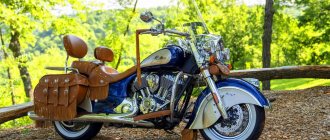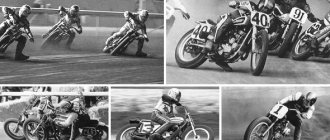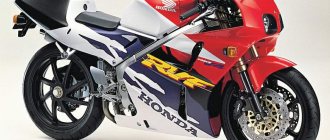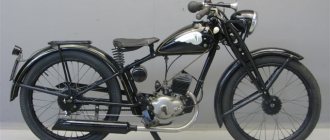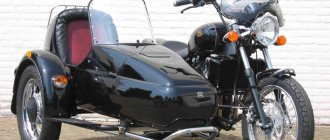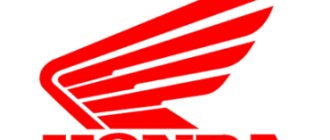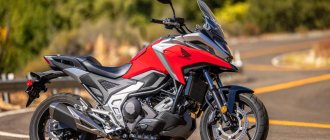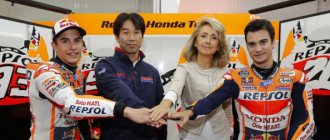In the family of a blacksmith, the son of Soichiro Honda, in his youth, mastered the specialty of an auto mechanic; in the early 1930s, he was one of the first in Japan to master the technology of making piston rings. And at the end of the war, Soichiro Honda had the opportunity to purchase a small number of two-stroke engines, which were originally designed and produced for installation on army portable generators. Since the country was practically ruined in the post-war years, and public transport was completely stopped. Soichiro Honda decides to install these engines on bicycle chassis.
The new company, named Honda Gijutsu Kenkyo, was registered in 1946. Initially, there was no complete certainty in the direction of development; the primary task was to sell a small batch of manufactured motorbikes, and to use the proceeds to purchase equipment for the production of machines for textile products. However, the demonstrated demand for the proposed motorbikes turned out to be very promising, and it was decided to master the development and production of our own power units. Already at the beginning of 1947, the production of two-stroke, single-cylinder 49 cc engines of the A series was launched, with a power of only 1 hp. within a year, the new product captured 66% of the domestic market.
1948 marked the beginning of the official history of Honda, which was marked by three significant events at once. First, a new engine production plant was launched in Hamamatsu. Secondly, together with the production of motorbikes, they began to produce cargo three-wheeled motorcycles of the B series. The third important event, and the history of the Honda company, was registration under the new name Honda Motor Co., Ltd. Currently one of the largest motorcycle concerns in the World. The first independent and full-fledged motorcycle in 1949 was the Honda D, the index D stood for Dream, which means dream. The motorcycle used a welded stamped perimeter, duplex frame with a rigid rear suspension, equipped with a two-stage gearbox and a single-cylinder two-stroke 9.8 cc, 3 hp. engine. The engine turned out to be very unsuccessful and difficult to modernize, so that the founder of Soichiro Honda took an oath not to develop units of this type. And in 1951, based on the Dream chassis, a four-stroke, 146 cc, overhead valve series E with a power of 5.5 hp was released. Following 1953, a lightweight Benly motorcycle model was released, which was a practical copy of the German Nsu Fox motorcycle.
January 1954 marked the debut of the heavy 170 kg, 189 cc Juno scooter with a power of 6.5 hp. In 1955, new models Dream SA (246 cm3, 11 hp) and SB (344 cm3, 15 hp) were released; the design also resembled the German brand NSU - only this time the model was Consul. In the history of Honda motorcycles, 1955 was the first year when the company took first place in the domestic motorcycle market. However, the founder's ambitions were much broader. Soichiro Honda organized an excursion to Europe in 1954. For the first time he was a spectator of the legendary Tourist Trophy race and swore that the devices of his production would be winners in these races in the near future.
The colorful history of Honda motorcycles begins with a new motorcycle developed in 1957, which was noticeably superior in technical characteristics to its classmates. Although the appearance of the Honda Dream C70 motorcycle showed the characteristic features of NSU, it was radically different from its prototype with a two-cylinder power unit producing 18 hp. and a volume of 250 cm3, and the rear wheel was driven by a chain, instead of the unreliable connecting rod-eccentric mechanism. In May 1958, two more motorcycles were produced: the first Dream C71 is equipped with an electric starter, the second is a sports 20-horsepower Dream Sport CS71, with wings raised up, which increases ground clearance. Since that time, Honda motorcycles have been equipped with electric starters, and almost all new products are developed in a sports-off-road version.
The most popular motorcycle of the time, the Honda Super Cub, was produced in 1958. It had a backbone frame, from below which an overhead valve 4.5 horsepower, 49 cc engine and an interlocked three-speed gearbox with an automatic centrifugal clutch were suspended. Thanks to its simplicity, efficiency, and reliability, the device has not yet lost its relevance, which to this day is in great demand, mainly in developing countries. Production of the model has already exceeded the 30 million limit. The generation of new Honda motorcycles quickly expanded its modifications. The presentation of the 124 cc 11-horsepower Dream C90 model took place in 1958, with a modernized engine derived from the miniature C70.
The new sports model “SV72”, debuted in 1959, like the European models, already acquired a telescopic front fork; The sportbike was equipped with a 247 cc two-cylinder engine, the power of which was 24 hp. The Super Cub received sports development in 1960 - and was introduced as the Super Cub C110. The new concept subsequently served as the basis, which over time grew into an independent family of light models with engines whose displacement ranged from 49 to 99 cm3.
brand history
The history of Honda began back in 1946.
Its founder was a Japanese engineer, inventor and simply a person who knows how to find innovative ways to solve problems - Soichiro Honda. Initially, he did not plan to open his own company, he simply loved to collect and improve two-wheeled vehicles. However, when he managed to assemble 10 mopeds for his friends, he decided to found the Honda Technical Research Institute. The company quickly gained momentum and within two years in 1948, from a small company producing motors and mopeds, it grew into an organization producing full-fledged motorcycles. In 1957, it opened its own research and development center and, in addition to Honda motorcycles, began developing cars, competing with such giants as Nissan and Toyota.
In subsequent years, the brand conquered the market, releasing more and more new models. The company soon became a leader in the production of vehicles, both motorcycles and cars.
The history of the development of Honda motorcycles in the 1970s.
In the 70s, an incredible rumor spread that engineers began developing motorcycles with two-stroke engines! This rumor was indeed confirmed in 1973, it was then that the market received two completely new models, the first CR was a cross-country model, the second MT model had a dual purpose. Both models had two-stroke engines with displacements of 123 and 246 cm3, respectively. However, the Honda MT model did not gain much popularity due to the crisis that broke out in the fuel market, which immediately drove two-stroke engines beyond the line. They were almost immediately replaced by XL and XR motorcycles, which were equipped with single-cylinder four-stroke engines. But two-stroke motocross motorcycles were serious contenders, but Belgian rider Andre Malherbe was able to win the first world championship title in the 500 cc class only in 1979.
Honda struck history again in 1974 with the introduction of the GL1000 Gold Wing, a new concept gold wing. The GL1000 Gold Wing motorcycle was equipped with a four-cylinder opposed liquid-cooled power unit, with a volume of 999 cm3 and power reaching 80 hp. The model was immediately appreciated by fans of motorcycle travel, especially in the American market. The 80s added fairings, luggage cases to the Honda GL1000 Gold Wing motorcycle, and ultimately, all production facilities were moved to the American continent.
1980 was the year the most powerful 115 horsepower, 1062 cc motorcycle Honda B1100R with six cylinders was launched into mass production. The leading position of medium cubic capacity was occupied in 1977 by the Honda CX500 motorcycle with a spinal tubular frame, equipped with a V-shaped 496 cc longitudinal twin with a power of 50 hp, with a liquid cooling system, having four valves per cylinder, and with a cardan transmission in the rear wheel. This technical layout became the basis for many subsequent models. This base also served in 1980 for the top model Honda CX500 Turbo with turbocharging, power - 82 hp. and developing a speed of 210 km/h. The motorcycle also acquired technical innovations - a ProLink rear suspension with a lever mechanism, over time it migrated to almost all on-road and off-road Honda models. Another novelty besides superbikes is the modest debut of the single-cylinder overhead valve Honda CG125 motorcycle, with a displacement of 124 cm3 and a power of only 14 hp, a power unit closed through the crankcase. The relatively simple and at the same time reliable design with fantastic efficiency won instant recognition, and it caused increased demand in third world countries. To this day, descendants of this model are produced in Asia and Latin America by Chinese manufacturers. In 1977, a new 49 cc scooter NF50 Vario was developed on 14-inch wheels with a two-stroke engine with a power of 3.6 horses, which was interlocked with an automatic V-belt variator. The following year, a modification on 10-inch NY50 Charlett wheels is released. The latest model clearly looks at the “real” of modern scooters, the development has been rapid. The real scooter comes out in 1980, the 50cc NS50 Tact. Following it, a series of models are almost immediately released. In 1981, a 49 cc, 3.8 horsepower three-wheeled Stream model was released, with a Star Wars-style two-stroke engine and a three-speed automatic transmission. 1982 saw the release of the futuristic Spacy, which had a four-stroke liquid-cooled engine with various displacements from 49 to 124 cm3, and a retractable headlight was installed in front. 1983 marked the debut of the Beat sports scooter, with a liquid-cooled two-stroke power unit boosted to 7.2 hp. The Honda Fusion scooter of the 80s was recognized as the uncrowned king, the debut of which took place in 1986. It was equipped with a four-stroke 244 cc liquid-cooled engine with a power of 20 hp.
In the late 70s, engineers were testing an extremely exotic design: a four-cylinder V-twin engine with oval pistons, with 8 valves per cylinder. Tests of the exotic NR500 motorcycle were not so successful; therefore, in the 80s, the Honda NS500 motorcycle with a three-cylinder V-shaped two-stroke engine was developed. And in 1983, the American athlete Freddie Spencer brought the 500 cc Honda NS500 sportbike to the championship podium. In 1984, Honda motorcycles were replenished with a new series of racing sportbikes NSR500, with V-shaped two-stroke engines. In 1981, Honda introduced the development of two classic road motorcycles, the VF750S Saber, producing 82 hp. and the second VF750C Magna – 75 hp. However, the popularity of the family did not last long, and in the 90s it faded away. The history of Honda motorcycles remembers models that are much more popular. These include the XLV750R motorcycle, released in 1982 with a 55-horsepower engine, a dual-purpose motorcycle. It is worth noting that this powerful device showed such impressive off-road performance. That this was recognized in the 80s with several gold awards at the Paris-Dakar. Since 1985, the American branch of the company began producing the Honda VT1100C Shadow cruiser, which was equipped with a 1099 cc engine producing 78 hp. The crowning achievement of this series was the debut of the VTX cruiser in 2000, which had an impressive displacement of 1,795 cm3 and maximum power of up to 107 hp. But the company's love for motorcycles with in-line fours has not cooled down. And in 1986, the developers introduced a new range of these liquid-cooled engines, featuring two overhead camshafts and four-valve cylinder heads. Honda motorcycles with these engines were distinguished by the presence of plastic fairings and a perimeter frame. Export options included the 598 cc 85 hp CBR600F and CBR1000F sports bike, and for the domestic market the 998 cc 135 hp CBR250. These motorcycle models have gained recognition and popularity in developed countries of the world. The company closely monitored the dynamics of demand and customer requests, which led to the modernization of models every 2-3 years. As a result, the engine power of, for example, a 600 cc motorcycle increased to 110 hp! A historical event in 1991 was the addition to this series of the CBR900RR Fireblade sportsbike, which translated as “Fire Blade,” which for the first time combined the incompatible power of a large 893 cc engine with a power of 124 hp. mounted on a compact frame of a light middle-class motorcycle weighing 185 kg, compared to 222 kg. model CBR1000F. In 1996, Honda released the 1137 cc sportsbike “Super Thrush”, one of the most powerful motorcycles in the world, CBR1100XX Super Blackbird, developing power of 164 hp! In 1992, the company's designers began developing the CB250 and CB400 models for the domestic market, for the Japanese, with liquid-cooled power units that were already used on sportbikes of the CBR models. Likewise, the engine borrowed from the CBR1000F sportbikes was installed in the classic CB1000 model in the same year. 1997 was the year the 600 cc, 96 hp model entered the world markets; in 2001, an updated 919 cc model with a power of 110 hp was released. One of the most extravagant neoclassicals is considered to be the 1999 X-Eleven, with a 140-horsepower derated engine with a volume of 1137 cm3 received from a CBR1100XX motorcycle which was installed on a diagonal frame made of aluminum alloy, and the instrument housing served as the aerodynamic lining necessary for such power together with the radiator guard. The history of Honda motorcycles also remembers the leaders in the touring line, which was the GL1500/6 Gold Ling, which debuted in 1987, equipped with a six-cylinder 1520 cc boxer power unit with a power of 100 hp, in front of which a large fairing and luggage cases were installed. The standard equipment included a stereo radio and CB radio; the motorcycle also had a reverse gear, which was driven by an electric starter and a variety of comfort-enhancing equipment. The touring motorcycle GL1500/6 Gold Ling produced an unprecedented effect, the reaction of competitors was predictable, the competition was stopped and soon they curtailed production and closed the development of their mega-touring models! For the European market, engineers developed and released in 1989 a lightweight 267 kg version of the motorcycle compared to the 362 kg GL1500/6 Gold Ling, followed by a very compact tourer ST1100 Pan European, equipped with a longitudinal 1084 cc, V-shaped four-cylinder engine with a power of 100 hp The motorcycle now has additional options; an ABS brake system can be installed upon request. At the turn of the century, both models were radically redesigned, as a result of which they acquired a much larger engine and, accordingly, increased power, a fuel injection system, and a diagonal frame made of aluminum alloy was developed to replace the old one made of steel pipes.
Honda did not stop developing racing engines and the Honda NS500 - a three-cylinder V-shaped power unit - was installed, which became the model for the debut 249 cc version of the MVX250, released in 1982, with a top speed of 165 km/h. The history of Honda devotes a separate column to the development and production of scooters, which remembers the bright bestsellers on the Japanese market. The 50cc DJ-1 scooter models produced from 1985 to 1989 gained enormous popularity. The beginning of the 90s was the start of the conquest of Japanese scooter models on the European market, models specially designed for this purpose and produced in their Italian and Spanish branches. In 2000, Honda introduced a two-cylinder, four-stroke 582 cc Silver Wing mega-scooter with a power of 49 hp, with a fuel injection system, the scooter was equipped with motorcycle-type suspension and a combined braking system with ABS.
Modern history of Honda motorcycles.
Honda has always been proud of its sports motorcycles, which allowed it to win the most prestigious champion titles and titles in both road racing, motocross, and rally raids. The history of the Honda company also has confirmed facts of innovation; engineers, for the first time in the world, decided to use a chassis made of aluminum alloys. The first to purchase an aluminum diagonal frame in 1977 was the Honda CR125R motocross motorcycle; a year later, an aluminum frame was being manufactured for its older brother CR250R. Somewhat later, in 1999, on a duplex frame made of aluminum alloy, the Enduro XR650R sports bike with a four-stroke 649 cc power unit with a power of 62 hp was released. A hit in 2002 on a duplex aluminum alloy frame was the Honda CRF450R cross-country motorcycle with a four-stroke 449 cc engine with a power of 55 hp. The design used all available experience both in motorcycle racing and skills in developing engines for racing sports cars in the Formula 1 class.
In 2002, the conditions of the FIM in the top class of road-circuit motorcycle racing changed: together with two-stroke 500 cc motorcycles, four-stroke motorcycles with 990 cc engines were also allowed to compete. Among all motorcycle manufacturers and competition participants, the Honda concern was fully prepared for the changes in the rules: it presented the RC211V motorcycle with a five-cylinder V-engine. With this sportbike, the Italian racer Valentino Rossi effortlessly wins almost all the prizes and becomes the world champion. Nowadays, the already famous company Motor Co., Ltd. - is a conglomerate with 75 factories in 38 countries, producing more than 5 million motorcycles. It is worth noting that not a significant part of the total quantity is produced directly in Japan itself and sold on the domestic market.
CB 650 F
Honda CB 650 F motorcycles are an excellent option for both beginners and more experienced drivers. A steel diagonal frame, a braking system with ABS, a monoshock absorber and a powerful engine from the CB 600 F will allow you to feel confident on almost any road. The design is quite modern and stylish, making the vehicle look good in any circumstances.
The most important advantage of the Honda CB 650 F motorcycle is its cost. The cost of this model is very low, which allows even a person with little income to purchase it.

